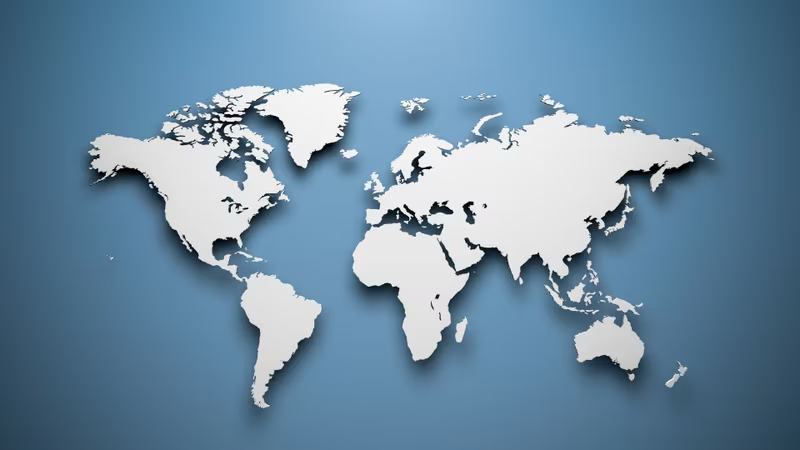The list of “richest” countries in the world in 2025 depends on how you measure their wealth. Economists usually compare countries by their GDP or total output, GDP per capita or wealth per citizen, GDP adjusted for cost of living or Purchasing power parity and Net National Wealth or Total assets - Total liabilities of the nation.
By total output or GDP, the United States of America is the wealthiest country in the world closely followed by China but by GDP per capita, the wealthiest countries in the world are Liechtenstein, Luxembourg, Ireland and Switzerland because they have small populations and access to rich resources like Oil & Petroleum.
Each method of ranking countries paints a different picture of the world economies and gives a unique insight into the economies.
This article lists the richest countries across all methods GDP, GDP per capita, PPP, and national wealth to measure key differences in the rankings of richest countries in the world between all methods.
How is wealth measured in countries?
Like we mentioned above, there is no one definition of the richest country in the world. It depends on the method you use to rank these countries. International organisations like International Monetary Fund (IMF) & the World Bank reply on some key measures to compare national economies which are listed below:
- Nominal GDP (Gross Domestic Product): Gross Domestic Product measures the total values of all goods and services produced at current market prices within the country’s defined borders
- GDP per capita: GDP Per capita is calculated by dividing the total Nominal GDP by the country’s population. This metric is used as a proxy for standard of living suggesting the total output generated per person.
- Purchasing Power Parity: PPP is Gross Domestic Product adjusted for differences in cost of living between countries. It measures the value of the common ‘basket of goods’ across countries for more accurate comparison of economic output.
- Total Wealth: Net National Wealth is calculated by taking the difference of a country’s assets (such as real estate, stocks, and natural resources) and its liabilities (like debt).
In this blog, we will rank the countries using the total wealth. This means we will use the current value of the dollar without adjusting for currency differences.
Richest Countries in the World by Total Wealth (Updated 2025)
Richest Countries Ranking
| Rank | Country | Nominal GDP (USD Billions) | GDP (PPP, USD Billions) | Total Wealth (USD Billions) | GDP Per Capita (USD) |
|---|
Source: Forbes.com
According to total wealth, the U.S., China, Japan, the United Kingdom, and Germany are the top five richest economies in the world.
1. United States
Sectors Contributing to GDP
The U.S. tops the list of richest countries in the world and leads the largest economies in the world. Its GDP is powered by technology, finance, healthcare, and entertainment. The per capita income of America remains among the highest globally.
Population
Roughly 347 million, making it the third most populous nation and the richest country in the world by total wealth.
Attractions
From the Grand Canyon to New York City’s skyline, the U.S. offers diverse cultural and natural wonders, fitting for the most richest country in the world.
2. China
Sectors Contributing to GDP
As the second-largest economy in the world, China dominates manufacturing, technology, and exports, standing tall among the top 5 richest countries in the world.
Population
About 1.4 billion, the highest in the list of countries by GDP.
Attractions
The Great Wall, Shanghai’s skyline, and ancient Xi’an reflect a nation that’s both historic and modern, a defining feature of one of the most richest countries in the world.
Build your wealth with digital gold savings on the Jar app.
3. Japan
Sectors Contributing to GDP
Japan, one of the top 10 most richest countries in the world, is a powerhouse of technology, automobiles, and electronics. Its innovation-driven economy consistently ranks high in the list of countries by GDP.
Population
Around 123 million, with a highly urbanized and ageing population.
Attractions
Tokyo’s skyline, Kyoto’s temples, and Mount Fuji make Japan a blend of tradition and progress, a defining trait of one of the wealthiest countries in the world.
4. United Kingdom
Sectors Contributing to GDP
The UK’s diversified economy, finance, services, and technology keep it among the top 10 richest countries in the world list.
Population
Nearly 67 million.
Attractions
London’s royal landmarks, Edinburgh’s castles, and the English countryside symbolize heritage and prosperity in one of the wealthiest countries in the world.
5. Germany
Sectors Contributing to GDP
Germany, Europe’s industrial engine, leads in automobiles, engineering, and exports. It’s central to the list of countries by GDP, ranking in the top 5 richest countries in the world.
Population
Around 84.9 million.
Attractions
Historic Berlin, Bavarian Alps, and Rhine castles — Germany represents strength among the largest economies in the world.
6. India
Sectors Contributing to GDP
India’s diverse economy spans IT, manufacturing, and agriculture, propelling it into the top 10 countries in the world by GDP (PPP) and one of the fastest-growing and richest countries in the world.
Population
Over 1.46 billion, the largest in the world.
Attractions
Taj Mahal, Jaipur’s forts, and Kerala’s backwaters make India culturally rich and economically dynamic. It surely positions itself as a future contender for the wealthiest countries in the world.
7. France
Sectors Contributing to GDP
Tourism, luxury goods, agriculture, and aerospace drive France’s economy, securing its spot in the top 10 most richest countries in the world.
Population
Around 67 million.
Attractions
The Eiffel Tower, the French Riviera, and world-class cuisine make France both the richest country in the world and a cultural leader.
8. Canada
Sectors Contributing to GDP
Canada’s economy thrives on natural resources, technology, and finance, positioning it among the top 10 most richest countries in the world.
Population
About 38 million, with high living standards and education quality.
Attractions
Niagara Falls, Banff National Park, and multicultural cities like Toronto make Canada a scenic gem among the top ten richest countries in the world.
9. South Korea
Sectors Contributing to GDP
Technology, electronics, and automotive industries position South Korea among the top 20 richest countries in the world.
Population
About 51 million.
Attractions
Seoul’s skyscrapers, Jeju Island, and K-pop culture show the blend of tradition and innovation in one of Asia’s wealthiest countries.
10. Italy
Sectors Contributing to GDP
Italy’s economy thrives on luxury goods, tourism, automotive, and agriculture, earning it a place among the top 20 richest country in the world.
Population
About 59 million.
Attractions
Rome’s Colosseum, Venice canals, and Tuscany’s vineyards showcase why Italy is both culturally iconic and among the most richest countries in the world.
11. Australia
Sectors Contributing to GDP
Australia’s economy is driven by mining, education, and tourism, ranking it among the top 10 richest countries in the world. Its natural resource wealth supports a high per capita income.
Population
Around 33 million, spread across modern cities and vast outback regions.
Attractions
Sydney Opera House, Great Barrier Reef, and pristine beaches make it a global favourite.
12. Spain
Sectors Contributing to GDP
Tourism, manufacturing, and agriculture make Spain part of the top 20 richest country in the world.
Population
Roughly 47 million
Attractions
Barcelona’s architecture, Madrid’s art museums, and Mediterranean beaches enrich one of Europe’s most wealthiest countries.
13. Taiwan
Sectors Contributing to GDP
Electronics & semiconductor manufacturing dominate Taiwan’s economy, led by companies like TSMC. Other key sectors include information technology, petrochemicals, machinery, and financial services.
Population
Around 23.6 million.
Attractions
Famous for Taipei 101, Taroko Gorge, Sun Moon Lake, and vibrant night markets. Taiwan also offers a rich cultural heritage, hot springs, and scenic mountain landscapes.
14. The Netherlands
Sectors Contributing to GDP
A global trade powerhouse, the Netherlands boasts one of the largest economies in the world. Key sectors include logistics, finance, and agriculture.
Population
Approximately 18 million.
Attractions
Amsterdam’s canals, tulip fields, and windmills highlight a balance of innovation and tradition in this wealthiest country in the world.
15. Switzerland
Sectors Contributing to GDP
Switzerland, often ranked among the top 10 most richest countries in the world, thrives on its strong service sector, banking, finance, and luxury manufacturing.
Pharmaceuticals, precision instruments, and watchmaking also make it one of the wealthiest countries in the world.
Population
Approximately 8.98 million, with one of the highest standards of living and GDP per capita globally.
Attractions
Home to the Alps, Lake Geneva, and Zurich’s old town, Switzerland’s natural beauty complements its reputation as one of the richest countries in the world and a hub for global finance.
16. Brazil
Sectors Contributing to GDP
Agriculture, mining, and energy anchor Brazil’s position in the list of the richest countries in the world and among the largest economies in the world.
Population
Around 213 million.
Attractions
The Amazon rainforest, Rio Carnival, and Iguazu Falls make Brazil a natural and cultural gem among the top 20 richest country in the world.
17. Russia
Sectors Contributing to GDP
Rich in natural resources, Russia’s economy is powered by energy, manufacturing, and defence, placing it in the list of the richest countries in the world by total asset base.
Population
Around 144 million.
Attractions
Moscow’s Red Square, the Hermitage Museum, and the Trans-Siberian Railway define Russia’s cultural and geographic vastness among the largest economies in the world.
18. Hong Kong
Sectors Contributing to GDP
Major GDP drivers include financial services, international trade, logistics, tourism, and real estate. Known as a global financial hub with one of the busiest ports in the world.
Population
Approximately 7.5 million.
Attractions
Popular attractions include Victoria Peak, Disneyland, Tian Tan Buddha, Avenue of Stars, and the city’s iconic skyline. Known for its food culture, shopping hubs, and harbour cruises.
19. Mexico
Sectors Contributing to GDP
Manufacturing, oil, and tourism make Mexico a strong contender among the top 20 richest country in the world.
Population
Roughly 132 million.
Attractions
Cancún beaches, Mayan ruins, and colonial towns contribute to Mexico’s reputation as one of the wealthiest countries in Latin America.
Find out what are the richest states in India (2025).
20. Indonesia
Sectors Contributing to GDP
Manufacturing, trade, and services drive Indonesia’s fast-growing economy — now one of the largest economies in the world.
Population
Nearly 286 million, making it the 4th most populous nation globally.
Attractions
Bali, Komodo Island, and Borobudur temple highlight Indonesia’s beauty and its rise in the list of the richest countries in the world.
Wealthiest Countries in the World (GDP per capita)
Now that we know the richest countries according to the total wealth of each country, let’s take a look at the richest countries by GDP per capita.
Here’s the table ranking the wealthiest countries by measuring wealth per person.
| Country | GDP Per Capita USD (Average earnings per person) |
| Liechtenstein | $231,713 |
| Luxembourg | $146,818 |
| Ireland | $111,047 |
| Switzerland | $98,150 |
| Iceland | $94,481 |
| Singapore | $91,884 |
| Norway | $89,599 |
| United States | $76,581 |
| Denmark | $74,921 |
| Macao | $73,174 |
| The Netherlands | $71,441 |
| Qatar | $65,946 |
| Australia | $65,269 |
| San Marino | $65,269 |
| Sweden | $62,036 |
| Austria | $61,694 |
| Belgium | $60,418 |
| Israel | $60,009 |
| Germany | $59,925 |
| Hong Kong | $56,844 |
FAQs
1. Which is the top 10 richest countries in the world?
The top 10 richest countries in the world by total wealth in 2025 are the United States, China, Japan, the United Kingdom, Germany, India, France, Canada, South Korea, and Italy.
| Country | Total Wealth (USD in billions) |
| United States | $163,117 |
| China | $91,082 |
| Japan | $21,332 |
| United Kingdom | $18,056 |
| Germany | $17,695 |
| India | $16,008 |
| France | $15,508 |
| Canada | $11,550 |
| South Korea | $11,041 |
| Italy | $10,600 |
| Australia | $10,500 |
| Spain | $9,153 |
| Taiwan | $6,081 |
| The Netherlands | $5,366 |
| Switzerland | $4,914 |
| Brazil | $4,835 |
| Russia | $4,608 |
| Hong Kong | $3,821 |
| Mexico | $3,783 |
| Indonesia | $3,591 |
2. Is India a rich country rank?
While India has a significant economy, it ranks 6th with a total wealth of $16,008 bn, according to 2025 estimates, placing it lower on the list when considering individual wealth but ranks 143rd globally on GDP Per Capita.
3. Which country is no 1 in money?
Based on GDP per capita for 2025, Liechtenstein is ranked as the number one country in terms of wealth per person, with a GDP per capita of $231,713.
4. Is Qatar the world's richest country?
No, while Qatar is a wealthy country, it is not ranked as the number one richest country in the world by GDP per capita in 2025; Liechtenstein holds that position. Qatar is ranked 12th with a GDP per capita of $65,946.










